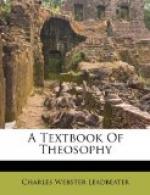Good thoughts produce vibrations of the finer matter of the body, which by its specific gravity tends to float in the upper part of the ovoid; whereas bad thoughts, such as selfishness and avarice, are always oscillations of the grosser matter, which tends to gravitate towards the lower part of the ovoid. Consequently the ordinary man, who yields himself not infrequently to selfish thoughts of various kinds, usually expands the lower part of his mental body, and presents roughly the appearance of an egg with its larger end downwards. The man who has repressed those lower thoughts, and devoted himself to higher ones, tends to expand the upper part of his mental body, and therefore presents the appearance of an egg standing on its smaller end. From a study of the colours and striations of a man’s mental body the clairvoyant can perceive his character and the progress he has made in his present life. From similar features of the causal body he can see what progress the ego has made since its original formation, when the man left the animal kingdom.
When a man thinks of any concrete object—a book, a house, a landscape—he builds a tiny image of the object in the matter of his mental body. This image floats in the upper part of that body, usually in front of the face of the man and at about the level of the eyes. It remains there as long as the man is contemplating the object, and usually for a little time afterwards, the length of time depending upon the intensity and the clearness of the thought. This form is quite objective, and can be seen by another person, if that other has developed the sight of his own mental body. If a man thinks of another, he creates a tiny portrait in just the same way. If his thought is merely contemplative and involves no feeling (such as affection or dislike) or desire (such as a wish to see the person) the thought does not usually perceptibly affect the man of whom he thinks.
If coupled with the thought of the person there is a feeling, as for example of affection, another phenomenon occurs besides the forming of the image. The thought of affection takes a definite form, which it builds out of the matter of the thinker’s mental body. Because of the emotion involved, it draws round it also matter of his astral body, and thus we have an astromental form which leaps out of the body in which it has been generated, and moves through space towards the object of the feeling of affection. If the thought is sufficiently strong, distance makes absolutely no difference to it; but the thought of an ordinary person is usually weak and diffused, and is therefore not effective outside a limited area.
When this thought-form reaches its object it discharges itself into his astral and mental bodies, communicating to them its own rate of vibration. Putting this in another way, a thought of love sent from one person to another involves the actual transference of a certain amount both of force and of matter from the sender to the recipient, and its effect upon the recipient is to arouse the feeling of affection in him, and slightly but permanently to increase his power of loving. But such a thought also strengthens the power of affection in the thinker, and therefore it does good simultaneously to both.




